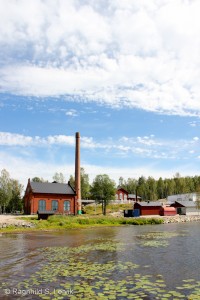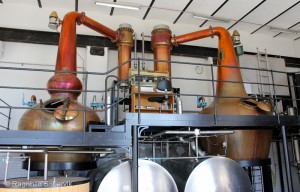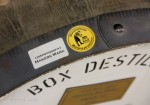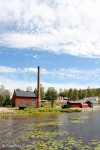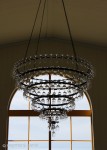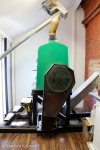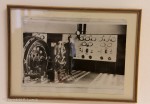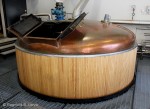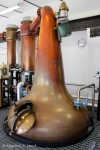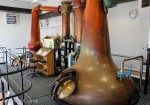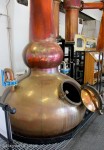Despite some confusion regarding the locations of both Tevsjö and Gammelstilla, we were confident that we could find Mackmyra, having passed this sign the day before:
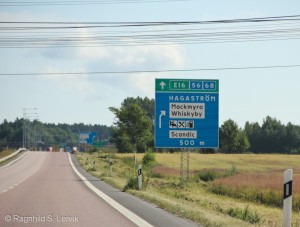 So we took the exit for Hagaström, and passed Mackmyra without noticing it at all… Once we realised we’d gone too far and turned around, it was very easy to spot the distillery, but from the direction we had come Mackmyra Whiskyby was hidden behind some trees.
So we took the exit for Hagaström, and passed Mackmyra without noticing it at all… Once we realised we’d gone too far and turned around, it was very easy to spot the distillery, but from the direction we had come Mackmyra Whiskyby was hidden behind some trees.
We had an appointment with Angela D’Orazio, Master Blender at Mackmyra, whom we have both met before. I attended her masterclass at one of the first Oslo Whiskyfestival where she presented Mackmyra from small casks (a long time before even Preludium was released). Since Mackmyra has a strict 15 years and over age restriction on their tours, we had to convince Angela to do two tours, one with each of us adults, while the other waited outside with the kids (passing time picking blueberries, which the woods around Mackmyra had plenty of). Luckily she agreed.
I was first, and we started the tour in the “skogslager” – the wood warehouse – which has been designed to fit into the surroundings with grass on the roof. Skogslageret is Mackmyra’s most recent warehouse, and they are continuously expanding it, adding a new module for every 1000 casks.
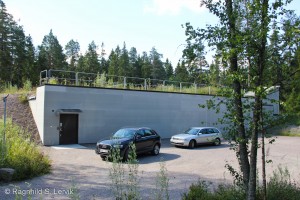 Small casks are rather appealing, I, for one, am always tempted to just grab one and make off with it…
Small casks are rather appealing, I, for one, am always tempted to just grab one and make off with it…
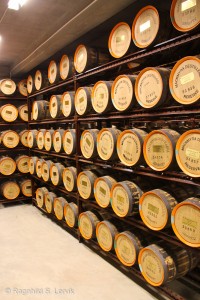 After the warehouse we had a look at the “rökanläggningen” – the “smokery” – which has been built in an old shipping container. That it works is evident when tasting the Mackmyra Svensk Rök, for example.
After the warehouse we had a look at the “rökanläggningen” – the “smokery” – which has been built in an old shipping container. That it works is evident when tasting the Mackmyra Svensk Rök, for example.
Finally, it was time for the actual distillery, and this was something we’d been looking foreward to. It’s always exciting to see a new (to us) distillery from the inside, but Mackmyra is rather special, being built as a gravitational plant. The most obvious effect of which is that the distillery building is TALL.
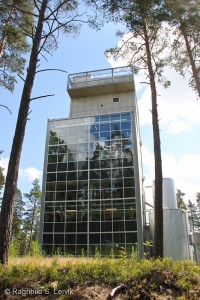 We started the tour by donning grey lab coats and climbing to the top floor. The top floor has a bit of a view.
We started the tour by donning grey lab coats and climbing to the top floor. The top floor has a bit of a view.
 A malt elevator brings the malt to the top of the building, and it is then dropped into the mill, which is the first part of the process that happens inside the skyscraper.
A malt elevator brings the malt to the top of the building, and it is then dropped into the mill, which is the first part of the process that happens inside the skyscraper.
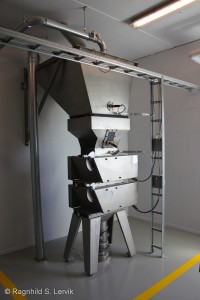 After milling, the grist “falls” one floor to the mashtun, where water is added and worts extracted. The worts run down another floor, to the washbacks, yeast is added and worts ferment into wash. And then the fun begins. Mackmyra have two pretty copper potstills of the traditional type.
After milling, the grist “falls” one floor to the mashtun, where water is added and worts extracted. The worts run down another floor, to the washbacks, yeast is added and worts ferment into wash. And then the fun begins. Mackmyra have two pretty copper potstills of the traditional type.

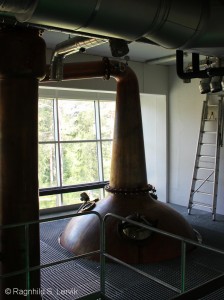
Here, or rather on the floor below the platform from where I took the pictures of the stills, we find another thing that is unique for Mackmyra (as far as I know). The old nordic term for “the thing the spirit runs through for visual inspection”, the spirit safe, is “spritklokke” (literally “spirit bell jar”). And spirit bell jars are exactly what we find at Mackmyra.
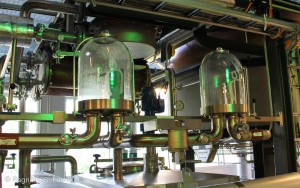 At this point I was sorely tempted to rub my hands together and cackle “Ahahahahaaa” in a mad scientisty way, the lab coat didn’t help at all.
At this point I was sorely tempted to rub my hands together and cackle “Ahahahahaaa” in a mad scientisty way, the lab coat didn’t help at all.
Shortly after our visit I came across an archive image from Romedal brenneri, of their “spritklokke”. It’s available online at Digitalt museum.
Had we been on holiday without children, we’d have booked a dinner and tasting in the restaurant at Mackmyra. As it was we were left to drool a bit at the bar.
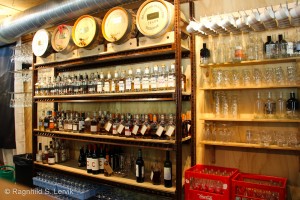 Since I don’t drive I got to have a quick couple of tastes, but the younger elements of our party were getting increasingly restless, so I had to accept that that was all I would get. I’ve since been able to try Mackmyra Midnattsol again in better conditions, but here are my quick impressions of two others:
Since I don’t drive I got to have a quick couple of tastes, but the younger elements of our party were getting increasingly restless, so I had to accept that that was all I would get. I’ve since been able to try Mackmyra Midnattsol again in better conditions, but here are my quick impressions of two others:
Mackmyra Moment Bärnsten (bottle number 1550 of 1550…!) 49.8% had orange peel, oak, thyme and a hint of smoke on the nose. It tasted of oak, orange peel and dark chocolate.
Mackmyra Moment Malström 46.4% had oak, cold rock and ashes on the nose, and tasted slightly bitter, with some congeners (of the good sort), honey, fruit and ashes.
I would happily have poured a sizeable dram of either of them and hidden myself away in a corner to enjoy it, but had to say nicely thank you for the tour and stuff the family into the car for the next leg of our Tour de Suède (it was our last morning in the Gävle area).
More pictures from Mackmyra in the gallery:
[Best_Wordpress_Gallery id=”7″ gal_title=”Mackmyra”]


